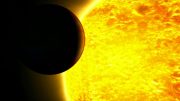
Researchers created the world’s fastest-spinning man-made object using laser light in a vacuum. Credit: University of St. Andrews
Using laser light in a vacuum, physicists were able to spin a microscopic sphere up to 600 million RPM, creating the fastest rotating man-made object.
A team of researchers at the University of St Andrews has created the world’s fastest-spinning man-made object.
Dr. Yoshihiki Arita, Dr. Michael Mazilu, and Professor Kishan Dholakia of the School of Physics and Astronomy at the University of St Andrews were able to levitate and spin a microscopic sphere, purely using laser light in a vacuum, briefly up to 600 million RPM before it broke apart.
This speed is half a million times faster than the spin speed of a domestic washing machine and more than a thousand times faster than a dental drill.
The work is published in the international journal Nature Communications.
Although there is much international research exploring what happens at the boundary between classical physics and quantum physics, most of this experimental work uses atoms or molecules. The St Andrews team aimed to understand what happened for larger objects containing a million million atoms or more.
To do this they manufactured a microscopic sphere of calcium carbonate only 4 millionths of a meter in diameter. The team then used the miniscule forces of laser light to hold the sphere with the radiation pressure of light – rather like levitating a beach ball with a jet of water.
They exploited the property of polarization of the laser light that changed as the light passed through the levitating sphere, exerting a small twist or torque.
Placing the sphere in vacuum largely removed the drag (friction) due to any gas environment, allowing the team to achieve the very high rotation rates.
In addition to the rotation, the team observed a “compression” of the excursions or “wobble” of the particle in all three dimensions, which can be understood as a “cooling” of the motion. Essentially the particle behaved like the world’s smallest gyroscope, stabilizing its motion around the axis of rotation.
Dr Yoshihiko Arita said: “This is an exciting, thought-provoking experiment that pushes the boundary of our understanding of rotating bodies.
“I am intrigued with the prospect of extending this to multiple trapped particles and rotating systems. We may even be able to shed light on the area of quantum friction – that is – does quantum mechanics put the brakes on the motion or spinning particle even though we are in a near-perfect vacuum with no other apparent sources of friction?”
Dr Michael Mazilu, a newly appointed lecturer in the School of Physics and Astronomy, said: “This system poses fascinating questions with regard to thermodynamics and is a challenging system to model theoretically. The rotation rate is so fast that the angular acceleration at the sphere surface is 1 billion times that of gravity on the Earth’s surface– it’s amazing that the centrifugal forces do not cause the sphere to disintegrate!”
Professor Kishan Dholakia said: “The team has performed a real breakthrough piece of work that we believe will resonate with the international community. In addition to the exciting fundamental physics aspects, this experiment will allow us to probe the nature of friction in very small systems, which has relevance to the next generation of microscopic devices. And it’s always good to hold a “world record” – even if for only a while!”
Reference: “Laser-induced rotation and cooling of a trapped microgyroscope in vacuum” by Yoshihiko Arita, Michael Mazilu and Kishan Dholakia, 28 August 2013, Nature Communications.
DOI: 10.1038/ncomms3374









I just wonder what effect the light that suspended the sphere and the laser light passing partially through the sphere had on the temperature of the calcium carbonate sphere. I suspect that the intensities of the light and the laser beams had to be quite high. In the near vacuum that was used any heat accumulation from the incident light would not easily escape from the sphere except via radiation at high temperature.
Suppose the experiment would have been done in a vessel with the wall temperature close to absolute zero. . then any heating up of the sphere would easily radiate away to the cold wall of the vessel and that would prevent the sphere from becoming very hot.
Perhaps then the maximum rotation speed might go several orders of magnitude higher???
That is fantastic. Here is a way to use light as a power house. Putting into space such a ‘globe’ with a magnetic moment would be able to sail through the universe on the magnetic lines of force with it’s created electrical spin..This should be a project on the space station.
This is an extremely imp breakthrough for energy crisis which we r facing today.
This has many applications for producing energy like mechanical enegy͵static energy͵ electricity explosives n much more.Great job guys….